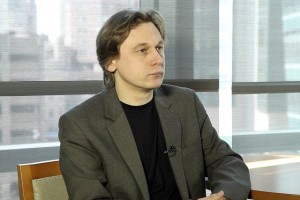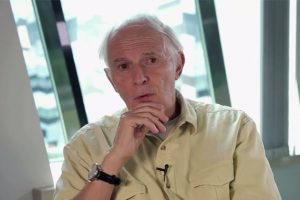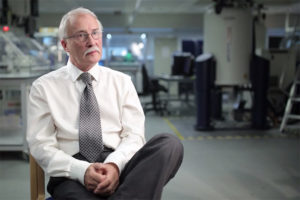Biology of Selenium
Geneticist Vadim Gladyshev on selenoprotein genes, the 21st amino acid, and selenium in human diet
A definition of ultrafast reactions depends on when you were born and when you lived because, in my time as an undergraduate, ultrafast meant that processes were taking place on the millisecond timescale, a thousandth of a second or even longer than that. Most photochemical reactions occur on a much faster time scale than milliseconds, so in order to study them, you have to have a pulse of light to initiate a photochemical reaction, which is short compared with the timescale of the existence of the excited electronic states you’re producing.
George Porter, a Nobel laureate in 1966, developed a system called flash photolysis, which gave you these short pulses of light, and so he was able ultimately to extend the time scale of reactions to the microsecond time scale, a thousand times faster than had been easily available beforehand. But that wasn’t fast enough either because the lifetime of an excited singlet state is of the order of 10-9 seconds, nanoseconds, or shorter, so you needed some way of getting a very short pulse of light on that sort of timescale, and with a discharge lamp which is what conventionally had been used in flash photolysis, this is not possible. The physics of the discharge through a lamp meant that you always got a longer pulse of light than you needed.
You asked yourself the question, what do you want to know about a chemical reaction which requires you to have these ultrafast techniques available? Ideally, you want to know how quickly the excited molecule relaxes down to other states and how quickly it interacts with other molecules, and we can also then study the precise and exact details of those interactions, which leads to the branch of the subject, which is called reaction dynamics. There, you are looking at individual molecules reacting with one another. Rather than an assembly of molecules, a whole large number of molecules, you can actually interrogate on a single molecular scale, and that tells you in absolutely wonderfully intimate details about the energy profile of molecules approaching one another, of the orientation in the space of the molecules, so what happens when the molecules react, and atoms change positions.
So you get structural information. If you’re using it as a technique for looking at this fluorescence on a complex molecule, you get a limited amount of information because it’s a large molecule that you’re looking at. If you want to get a better understanding of how the atoms move in a molecule when it’s excited and when it’s undergoing these other processes, you need a technique which allows you to get that structural information. One of the techniques we have used in my group has been to look at the vibrational spectroscopy of the excited electronic molecule.
Molecules vibrate, the atoms vibrate against one another, and the frequency at which they do that is characteristic not only of what atoms you have there, but the environment in which the atoms are, the structure of the molecule.
You can, if you’re lucky, see changes in those vibrations as the molecule rearranges or passes on its energy to other species.
So, time-resolved vibrational spectroscopy opened up a whole new area of research. There are two ways you can do the vibrational spectroscopy. One is to use a scattering technique called Raman spectroscopy where you use a second visible laser, which is the interrogatory laser, so you pulse the system with the laser which causes the excitation of a molecule, and then you interrogate with the second pulse of light from a different laser which is trying to get this structural information. You’re using visible light, and most of the visible light is scattered at the same frequency as the incident light, and that’s not terribly interesting, but some of it is changed by the frequency of one of the vibrations that you have either excited or de-excited. So, you can measure the infrared spectrum effectively of an excited electronic state, which may exist for as little as 10-12 of a second for a picosecond. So, you work on a very fast time scale to see changes in the structure of these excited states.
Subsequent to the use of time-resolved Raman spectroscopy, which is still used, it was discovered that you can get an infrared spectrum using infrared absorption as the interrogatory technique. That gives you much more detail because vibration in a molecule which is infrared-active is not Raman-active; they’re usually mutually exclusive, so what you can do with Raman you cannot do with infrared and vice-versa. The two techniques are very complementary.
So we can get the same level of understanding of an incredibly short-lived excited state that we have of a ground-state molecule. That has led to a kind of explosion of interest in the reaction dynamics of any photochemical reaction. In principle, there is no limit to the number of studies you can make on excited electronic states because a ground-state molecule will absorb maybe one, two or three different singlet states where the electron is moving to different orbitals, and they will decay (and they will decay obviously to the triplet state also). And so you have easily accessible as many as four different electronically excited states in a typical molecule, and these will undergo different reactions because what determines chemical reactivity is where the electrons are in space, and if you move one of these electrons to different regions of space, you would expect it to behave chemically differently from its parent ground-state molecule, and indeed that is the case. So, the potential for ultrafast reactions, the reactions of electronically excited states, is four or five times greater than the whole of ground-state chemistry, which has developed over the past couple of centuries. So we’re just scratching at the surface of what is possible, but these are very exciting times.

Geneticist Vadim Gladyshev on selenoprotein genes, the 21st amino acid, and selenium in human diet

Сhemist Harold Kroto on radio astronomy, fullerenes, and discovery making

Biochemist Ian Wilson on toxicity of paracetamol, clinical trials, and safe drugs